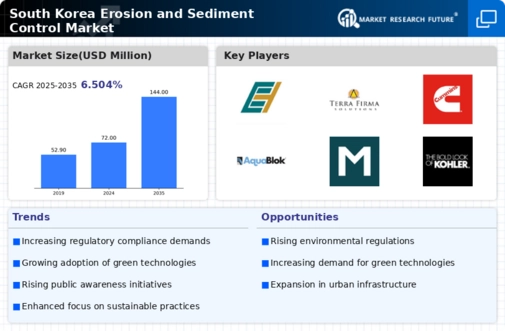Environmental Policy Initiatives
The erosion and-sediment-control market in South Korea is significantly influenced by the government's commitment to environmental policy initiatives. These policies aim to mitigate soil erosion and sedimentation, particularly in vulnerable areas. The South Korean government has implemented various regulations that mandate the use of erosion control measures in construction and land development projects. This regulatory environment is expected to drive market growth, as compliance with these policies often necessitates the adoption of advanced erosion control technologies. Furthermore, the government's investment in sustainable land management practices is projected to increase the market's value, with estimates suggesting a growth rate of approximately 6% annually over the next five years. As such, the erosion and-sediment-control market is likely to benefit from these proactive measures aimed at preserving natural resources and promoting ecological balance.
Climate Change Adaptation Strategies
The erosion and-sediment-control market is increasingly shaped by the need for climate change adaptation strategies in South Korea. As extreme weather events become more frequent, the risk of soil erosion and sedimentation rises, prompting the need for effective control measures. The South Korean government has initiated various programs aimed at enhancing resilience to climate change, which includes funding for erosion control projects. Reports indicate that the market could see a growth of approximately 5% annually as stakeholders recognize the importance of integrating erosion control into climate adaptation plans. This trend suggests that the erosion and-sediment-control market will play a vital role in safeguarding infrastructure and natural resources against the adverse effects of climate change, thereby driving demand for innovative solutions.
Public and Private Sector Collaboration
Collaboration between the public and private sectors is emerging as a key driver of the erosion and-sediment-control market in South Korea. This partnership facilitates the sharing of resources, knowledge, and technology, which is essential for developing effective erosion control solutions. Public agencies are increasingly engaging with private companies to implement innovative erosion control projects, particularly in urban and rural areas. This collaboration is likely to enhance the market's growth, as it fosters the development of advanced technologies and practices that address erosion challenges. Furthermore, joint initiatives often attract funding from both government and private sources, which can significantly boost project implementation. As a result, the erosion and-sediment-control market is expected to benefit from this synergistic approach, leading to improved outcomes in soil conservation and sediment management.
Urbanization and Infrastructure Development
Rapid urbanization in South Korea is a critical driver of the erosion and-sediment-control market. As cities expand, the demand for infrastructure development increases, leading to significant land disturbance and soil erosion. The construction of roads, buildings, and other infrastructure projects often results in increased sediment runoff, necessitating effective erosion control solutions. The South Korean government has recognized this challenge and is investing heavily in infrastructure projects, with an estimated budget of over $100 billion allocated for urban development in the coming years. This investment is likely to create a substantial demand for erosion and sediment control products and services, as developers seek to comply with environmental regulations and minimize the ecological impact of their projects. Consequently, the erosion and-sediment-control market is poised for growth as urbanization continues to reshape the landscape.
Agricultural Practices and Soil Conservation
Agricultural practices in South Korea are a significant driver of the erosion and-sediment-control market. With agriculture being a vital sector of the economy, the need for soil conservation has become increasingly apparent. Farmers are adopting various erosion control techniques to maintain soil health and productivity, which is essential for sustainable agricultural practices. The government has introduced programs that promote the use of erosion control measures in farming, including subsidies for implementing best management practices. This initiative is expected to enhance the market, as it encourages farmers to invest in erosion control technologies. The erosion and-sediment-control market could potentially experience a growth rate of around 4% annually, driven by the agricultural sector's commitment to sustainable practices and soil conservation.


















Leave a Comment